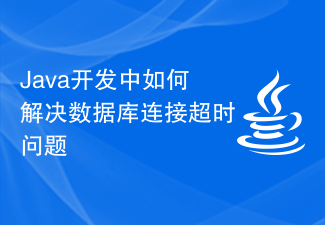
As a widely used programming language, Java occupies an important position in software development. During the development process, ensuring code quality and conducting code reviews are very important links. This article will introduce how to conduct code quality detection and code review in Java development, and give specific code examples.
1. Code quality detection tools
In Java development, we can use some code quality detection tools to help us discover potential problems in the code, thereby improving the quality of the code. Commonly used code quality detection tools include Checkstyle, FindBugs, PMD, etc.
- Checkstyle
Checkstyle is a powerful static code analysis tool that can be used to check whether the coding style of the code complies with the specification. It can check code indentation, naming conventions, comment conventions, etc., and provide corresponding warning or error messages.
The following is an example of using Checkstyle to check the code style:
// CheckstyleTest.java
public class CheckstyleTest {
private int variable; // 类级别的变量,命名规范应该是小驼峰式(variable)
public CheckstyleTest() {
this.variable = 0; // 缩进应该使用4个空格
}
public void setVariable(int variable) {
this.variable = variable; // 对象级别的变量,命名规范应该是小驼峰式(variable)
}
public void calculate() {
int result = 0;
for (int i = 0; i < 10; i++) { // for循环应该使用花括号{}包裹
result += i;
}
}
public static void main(String[] args) {
CheckstyleTest test = new CheckstyleTest();
test.calculate();
}
}Through the above example code, we can run the Checkstyle tool to check the code style to ensure the unity and standardization of the code.
- FindBugs
FindBugs is a static analysis tool used to check for potential errors and defects in Java code. It can check problems such as null pointer references, unrealized resources, code block exceptions, etc., and give corresponding warning or error messages.
The following is an example of using FindBugs to check for potential errors:
// FindBugsTest.java
public class FindBugsTest {
public static void main(String[] args) {
String str = null;
System.out.println(str.length()); // 空指针引用
}
}With the above example code, we can run the FindBugs tool for potential error checking, thereby avoiding unhandled errors at runtime exception.
- PMD
PMD is a code defect detection tool that can help us find some common problems in Java code, such as outdated methods, use of deprecated APIs, etc. It provides corresponding warning or error information through static code analysis.
The following is an example of using PMD to check common problems:
// PMDTest.java
public class PMDTest {
public static void main(String[] args) {
System.out.println("Test"); // 过时的方法
}
public void foo() {
Hashtable<Integer, String> hashtable = new Hashtable<Integer, String>(); // 使用了不推荐的API
}
}Through the above example code, we can run the PMD tool to check for common problems, thereby avoiding mistakes during the development process Some low-level errors.
2. Code review practice
In addition to using code quality detection tools, we can also conduct code reviews to discover potential problems. Code review is to manually read the code to find defects and potential problems in the code, and provide corresponding suggestions and improvements.
The following is a practical example for code review:
public class CodeReviewTest {
public int sum(int a, int b) {
return a + b;
}
public static void main(String[] args) {
CodeReviewTest test = new CodeReviewTest();
int result = test.sum(1, 2);
System.out.println("Result: " + result);
}
}In the above example code, there is a sum method used to add two integers. However, through code review, we can find that the name of this method is not descriptive enough, and it is recommended to change it to add to better express its function. In addition, the lack of comments and exception handling in the code are also areas that need optimization.
Through the above examples, we can see that code review can help us improve the quality of the code, discover and solve existing problems, thereby speeding up the software development process.
To summarize, in Java development, by using code quality detection tools and conducting code reviews, we can discover potential problems in the code and improve the quality of the code. These tools and practices help us develop efficient, robust, and maintainable Java applications.
The above is the detailed content of How to conduct code quality detection and code review in Java development. For more information, please follow other related articles on the PHP Chinese website!
 如何使用Go语言进行代码审查实践Aug 02, 2023 pm 11:10 PM
如何使用Go语言进行代码审查实践Aug 02, 2023 pm 11:10 PM如何使用Go语言进行代码审查实践引言:在软件开发过程中,代码审查(CodeReview)是一种重要的实践。通过互相检查和分析代码,团队成员可以发现潜在的问题、改进代码质量、增加团队合作和共享知识。本文将介绍如何使用Go语言进行代码审查实践,并附上代码示例。一、代码审查的重要性代码审查是一种促进代码质量的最佳实践。它可以发现和纠正代码中的潜在错误、提高代码可
 Python开发经验分享:如何进行代码审查和质量保证Nov 22, 2023 am 08:18 AM
Python开发经验分享:如何进行代码审查和质量保证Nov 22, 2023 am 08:18 AMPython开发经验分享:如何进行代码审查和质量保证导言:在软件开发过程中,代码审查和质量保证是至关重要的环节。良好的代码审查可以提高代码质量、减少错误和缺陷,提高程序的可维护性和可扩展性。本文将从以下几个方面分享Python开发中如何进行代码审查和质量保证的经验。一、制定代码审查规范代码审查是一种系统性的活动,需要对代码进行全面的检查和评估。为了规范代码审
 Java开发中如何解决数据库连接超时问题Jun 29, 2023 am 09:40 AM
Java开发中如何解决数据库连接超时问题Jun 29, 2023 am 09:40 AMJava开发中如何解决数据库连接超时问题简介:在Java开发中,处理数据库是非常常见的任务之一。尤其是在Web应用程序或后端服务中,与数据库的连接经常需要进行长时间的操作。然而,随着数据库的规模不断增大和访问请求的增加,数据库连接超时问题也开始变得常见。本文将讨论在Java开发中如何解决数据库连接超时问题的方法和技巧。一、理解数据库连接超时问题在开始解决数据
 Java开发中如何进行代码审查和性能优化Oct 10, 2023 pm 03:05 PM
Java开发中如何进行代码审查和性能优化Oct 10, 2023 pm 03:05 PMJava开发中如何进行代码审查和性能优化,需要具体代码示例在日常的Java开发过程中,代码审查和性能优化是非常重要的环节。代码审查能够确保代码的质量和可维护性,而性能优化则能够提升系统的运行效率和响应速度。本文将介绍如何进行Java代码审查和性能优化,并且给出具体的代码示例。代码审查代码审查是在代码编写的过程中逐行检查代码,并修复潜在的问题和错误的过程。以下
 React代码审查指南:如何确保前端代码的质量和可维护性Sep 27, 2023 pm 02:45 PM
React代码审查指南:如何确保前端代码的质量和可维护性Sep 27, 2023 pm 02:45 PMReact代码审查指南:如何确保前端代码的质量和可维护性引言:在今天的软件开发中,前端代码越来越重要。而React作为一种流行的前端开发框架,被广泛应用于各种类型的应用程序中。然而,由于React的灵活性和强大的功能,编写高质量和可维护的代码可能会成为一个挑战。为了解决这个问题,本文将介绍一些React代码审查的最佳实践,并提供一些具体的代码示例。一、代码风
 PHP 代码审查与持续集成May 06, 2024 pm 03:00 PM
PHP 代码审查与持续集成May 06, 2024 pm 03:00 PM是的,将代码审查与持续集成相结合可以提高代码质量和交付效率。具体工具包括:PHP_CodeSniffer:检查编码风格和最佳实践。PHPStan:检测错误和未使用的变量。Psalm:提供类型检查和高级代码分析。
 C#开发注意事项:代码审查与质量保障Nov 22, 2023 pm 05:00 PM
C#开发注意事项:代码审查与质量保障Nov 22, 2023 pm 05:00 PM在C#开发过程中,代码的质量保障是至关重要的。代码质量的高低直接影响着软件的稳定性、可维护性和可扩展性。而代码审查作为一种重要的质量保障手段,在软件开发中发挥着不可忽视的作用。本文将重点介绍C#开发中的代码审查注意事项,以帮助开发者提升代码质量。一、审查的目的与意义代码审查是指通过仔细阅读和检查代码,发现和纠正其中存在的问题和错误的过程。它的主要目的是提高代
 如何优化Java开发中的随机数生成算法Jun 29, 2023 am 09:39 AM
如何优化Java开发中的随机数生成算法Jun 29, 2023 am 09:39 AM如何优化Java开发中的随机数生成算法随机数在计算机科学中扮演着非常重要的角色,在很多应用中都有广泛的应用,例如密码学、游戏、模拟等。在Java开发中,随机数生成算法是一个常见的需求,本文将介绍如何优化Java开发中的随机数生成算法,以提高性能和安全性。Java中随机数生成的主要依靠java.util.Random类。这个类使用48位种子来生成伪随机数,但是


Hot AI Tools

Undresser.AI Undress
AI-powered app for creating realistic nude photos

AI Clothes Remover
Online AI tool for removing clothes from photos.

Undress AI Tool
Undress images for free

Clothoff.io
AI clothes remover

AI Hentai Generator
Generate AI Hentai for free.

Hot Article

Hot Tools

Dreamweaver CS6
Visual web development tools

WebStorm Mac version
Useful JavaScript development tools

Zend Studio 13.0.1
Powerful PHP integrated development environment

SAP NetWeaver Server Adapter for Eclipse
Integrate Eclipse with SAP NetWeaver application server.

Safe Exam Browser
Safe Exam Browser is a secure browser environment for taking online exams securely. This software turns any computer into a secure workstation. It controls access to any utility and prevents students from using unauthorized resources.





